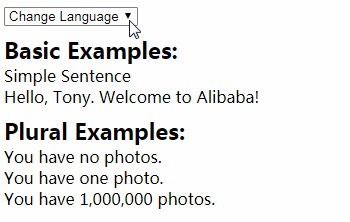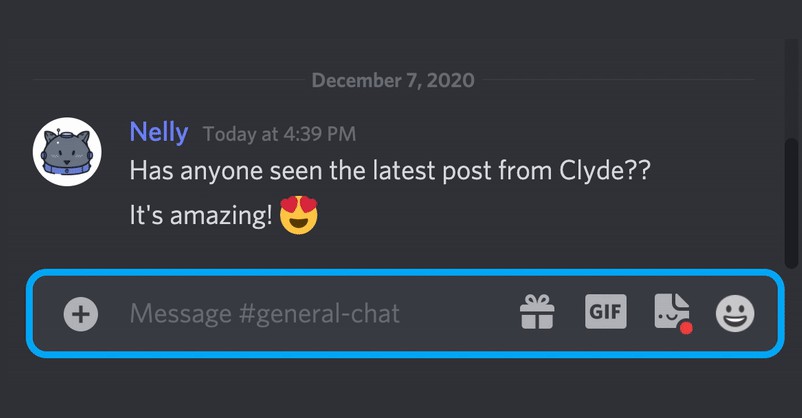react-intl-universal
react-intl-universal is a React internationalization package developed by Alibaba Group.
Features
Can be used not only in React.Component but also in Vanilla JS.
Simple. Only three main API and one optional helper.
Display numbers, currency, dates and times for different locales.
Pluralize labels in strings.
Support variables in message.
Support HTML in message.
Automatically load Common Locale Data Repository (CLDR) locale data on demand. It's used for displaying numbers, currency, dates and times accordingly.
Support for 150+ languages.
Runs in the browser and Node.js.
Message format is strictly implemented by ICU standards.
Locale data in nested JSON format are supported.
Why Another Internationalization Solution for React?
In case of internationalizing React apps, react-intl is one of most popular package in industry. react-intl decorate your React.Component with wrapped component which is injected internationalized message dynamically so that the locale data is able to be loaded dynamically without reloading page. The following is the example code using react-intl.
import { injectIntl } from 'react-intl';
class MyComponent extends Component {
render() {
const intl = this.props;
const title = intl.formatMessage({ id: 'title' });
return (<div>{title}</div>);
}
};
export default injectIntl(MyComponent);
However, this approach introduces two major issues.
Firstly, Internationalizing can be applied only in view layer such as React.Component. For Vanilla JS file, there's no way to internationalize it. For example, the following snippet is general form validator used by many React.Component in our apps. We definitely will not have such code separated in different React.Component in order to internationalize the warning message. Sadly, react-intl can't be used in Vanilla JS.
export default const rules = {
noSpace(value) {
if (value.includes(' ')) {
return 'Space is not allowed.';
}
}
};
Secondly, since your React.Component is wrapped by another class, the behavior is not as expected in many way. For example, to get the instance of React.Component, you can't use the normal way like:
class App {
render() {
<MyComponent ref="my"/>
}
getMyInstance() {
console.log('getMyInstance', this.refs.my);
}
}
Instead, you need to use the method getWrappedInstance() to get that.
class MyComponent {...}
export default injectIntl(MyComponent, {withRef: true});
class App {
render() {
<MyComponent ref="my"/>
}
getMyInstance() {
console.log('getMyInstance', this.refs.my.getWrappedInstance());
}
}
Furthermore, your React.Component's properties are not inherited in subclass since component is injected by react-intl.
Due to the problem above, we create react-intl-universal to internationalize React app using simple but powerful API.
Get Started
Install
npm install react-intl-universal --save
Initialize
In the following example, we initialize intl with app locale data (locales) and determine which locale is used dynamically (currentLocale). Then use intl.get(...) to get the internationalized message. That's all. Pretty simple!
Note that you are not necessary to load all locale data, just load the current locale data on demand. Please refer the example for more detail.
import intl from 'react-intl-universal';
// locale data
const locales = {
"en-US": require('./locales/en-US.js'),
"zh-CN": require('./locales/zh-CN.js'),
};
class App extends Component {
state = {initDone: false}
componentDidMount() {
this.loadLocales();
}
loadLocales() {
// init method will load CLDR locale data according to currentLocale
// react-intl-universal is singleton, so you should init it only once in your app
intl.init({
currentLocale: 'en-US', // TODO: determine locale here
locales,
})
.then(() => {
// After loading CLDR locale data, start to render
this.setState({initDone: true});
});
}
render() {
return (
this.state.initDone &&
<div>
{intl.get('SIMPLE')}
</div>
);
}
}
HTML Message
As shown in above example, the get method returns string message. For HTML message, use getHTML instead. For example,
Locale data:
{ "TIP": "This is <span style='color:red'>HTML</span>" }
JS code:
intl.getHTML('TIP'); // {React.Element}
Default Message
When the specific key does't exist in current locale, you may want to make it return a default message. Use defaultMessage method after get method. For example,
JS code:
intl.get('not-exist-key').defaultMessage('default message') // "default message"
Or using d for short:
intl.get('not-exist-key').d('default message') // "default message"
And getHTML also supports default message.
intl.getHTML('not-exist-key').d(<div>hello</div>) // React.Element with "<div>hello</div>"
Message With Variables
If the message contains variables the {variable_name} is substituted directly into the string. In the example below, there are two variables {name} and {where}, the second argument representing the variables in get method are substituted into the string.
Locale data:
{ "HELLO": "Hello, {name}. Welcome to {where}!" }
JS code:
intl.get('HELLO', {name:'Tony', where:'Alibaba'}) // "Hello, Tony. Welcome to Alibaba!"
Plural Form and Number Thousands Separators
Locale data:
{ "PHOTO": "You have {num, plural, =0 {no photos.} =1 {one photo.} other {# photos.}}" }
JS code:
intl.get('PHOTO', {num:0}); // "You have no photos."
intl.get('PHOTO', {num:1}); // "You have one photo."
intl.get('PHOTO', {num:1000000}); // "You have 1,000,000 photos."
Plural label supports standard ICU Message syntax.
Number thousands separators also varies according to the user's locale. According to this document, United States use a period to indicate the decimal place. Many other countries use a comma instead.
Display Currency
Locale data:
{ "SALE_PRICE": "The price is {price, number, USD}" }
JS code:
intl.get('SALE_PRICE', {price:123456.78}); // The price is $123,456.78
As mentioned, the locale data is in ICU Message format.
The syntax is {name, type, format}. Here is description:
- name is the variable name in the message. In this case, it's
price. - type is the type of value such as
number,data, andtime. - format is optional, and is additional information for the displaying format of the value. In this case, it's
USD.
if type is number and format is omitted, the result is formatted number with thousands separators. If format is one of currency code, it will show in corresponding currency format.
Display Dates
Locale data:
{
"SALE_START": "Sale begins {start, date}",
"SALE_END": "Sale ends {end, date, long}"
}
JS code:
intl.get('SALE_START', {start:new Date()}); // Sale begins 4/19/2017
intl.get('SALE_END', {end:new Date()}); // Sale ends April 19, 2017
If type is date, format has the following values:
shortshows date as shortest as possiblemediumshows short textual representation of the monthlongshows long textual representation of the monthfullshows dates with the most detail
Display Times
Locale data:
{
"COUPON": "Coupon expires at {expires, time, medium}"
}
JS code:
intl.get('COUPON', {expires:new Date()}); // Coupon expires at 6:45:44 PM
if type is time, format has the following values:
shortshows times with hours and minutesmediumshows times with hours, minutes, and secondslongshows times with hours, minutes, seconds, and timezone
Common Locale Data
For browser rendering, the common locale data such as date, currency, and number format are automatically loaded from CDN on demand.
For server-side rendering, they should be added in your application as shown in the example.
// For Node.js
import IntlPolyfill from "intl";
global.Intl = IntlPolyfill;
require('intl/locale-data/jsonp/en.js');
require('intl/locale-data/jsonp/zh.js');
require('intl/locale-data/jsonp/fr.js');
require('intl/locale-data/jsonp/ja.js');
Helper
react-intl-universal provides a utility helping developer determine the user's current locale. As the running examples, when user select a new locale, it redirect user new location like http://localhost:3000?lang=en-US. Then, we can use intl.determineLocale to get the locale from URL. It can also support determine user's locale via cookie and browser default language. Refer to the APIs section for more detail.
APIs Definition
/**
* Initialize properties and load CLDR locale data according to currentLocale
* @param {Object} options
* @param {string} options.currentLocale Current locale such as 'en-US'
* @param {string} options.locales App locale data like {"en-US":{"key1":"value1"},"zh-CN":{"key1":"值1"}}
* @param {Object} options.warningHandler Ability to accumulate missing messages using third party services like Sentry. See https://github.com/alibaba/react-intl-universal/releases/tag/1.11.1
* @returns {Promise}
*/
init(options)
/**
* Load more locales after init
* @param {Object} locales App locale data
*/
load(locales)
/**
* Get the formatted message by key
* @param {string} key The string representing key in locale data file
* @param {Object} variables Variables in message
* @returns {string} message
*/
get(key, variables)
/**
* Get the formatted html message by key.
* @param {string} key The string representing key in locale data file
* @param {Object} variables Variables in message
* @returns {React.Element} message
*/
getHTML(key, options)
/**
* Helper: determine user's locale via URL, cookie, and browser's language.
* You may not this API, if you have other rules to determine user's locale.
* @param {string} options.urlLocaleKey URL's query Key to determine locale. Example: if URL=http://localhost?lang=en-US, then set it 'lang'
* @param {string} options.cookieLocaleKey Cookie's Key to determine locale. Example: if cookie=lang:en-US, then set it 'lang'
* @returns {string} determined locale such as 'en-US'
*/
determineLocale(options)
/**
* Get the inital options
* @returns {Object} options includes currentLocale and locales
*/
getInitOptions()
Compatibility with react-intl
As mentioned in the issue Mirror react-intl API, to make people switch their existing React projects from react-intl to react-intl-universal. We provide two compatible APIs as following.
/**
* As same as get(...) API
* @param {Object} options
* @param {string} options.id
* @param {string} options.defaultMessage
* @param {Object} variables Variables in message
* @returns {string} message
*/
formatMessage(options, variables)
/**
* As same as getHTML(...) API
* @param {Object} options
* @param {string} options.id
* @param {React.Element} options.defaultMessage
* @param {Object} variables Variables in message
* @returns {React.Element} message
*/
formatHTMLMessage(options, variables)
For example, the formatMessage API
const name = 'Tony';
intl.formatMessage({ id:'hello', defaultMessage: `Hello, ${name}`}, {name});
is equivalent to get API
const name = 'Tony';
intl.get('hello', {name}).d(`Hello, ${name}`);
And the formatHTMLMessage API
const name = 'Tony';
intl.formatHTMLMessage({ id:'hello', defaultMessage: <div>Hello</div>}, {name});
is equivalent to getHTML API
const name = 'Tony';
intl.getHTML('hello', {name}).d(<div>Hello</div>);
Browser Compatibility
Before using react-intl-universal, you need to include scripts below in HTML to support older browser.
<!--[if lt IE 9]>
<script src="//f.alicdn.com/es5-shim/4.5.7/es5-shim.min.js"></script>
<![endif]-->
<script>
if(typeof Promise!=="function"){document.write('<script src="//f.alicdn.com/es6-shim/0.35.1/??es6-shim.min.js,es6-sham.min.js"><\/script>')}
</script>
Running Examples Locally
git clone [email protected]:alibaba/react-intl-universal.git
For browser rendering,
cd react-intl-universal/examples/browser-example
npm install
npm start
For server-side rendering,
cd react-intl-universal/examples/node-js-example
npm install
npm start





